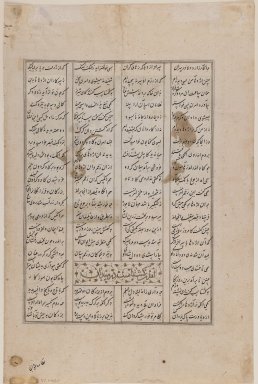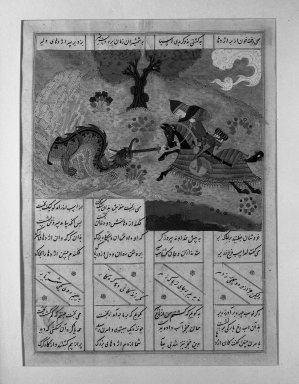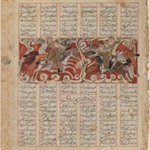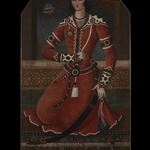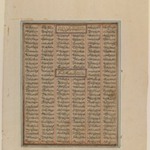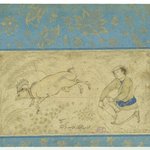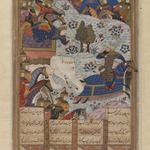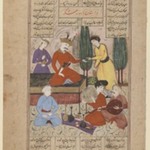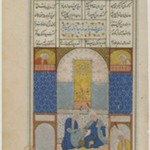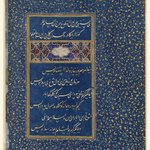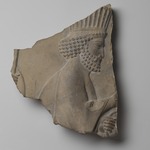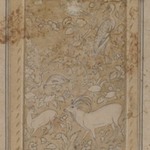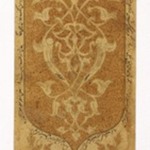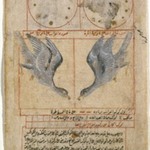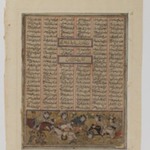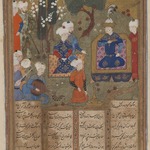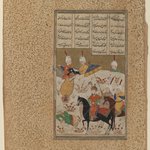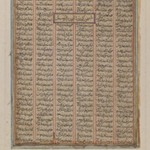Gushtasp Slaying the Dragon, Page from an Illustrated Manuscript of the Shahnama of Firdawsi
Arts of the Islamic World
The legendary Iranian prince Gushtasp slays a terrifying dragon in this frequently illustrated scene from the Shāhnāma (Book of Kings), put to verse by the poet Firdawsi around 1010. Denied the throne by his father, the prince Gushtasp left Iran only to return triumphantly after proving his worth against the dragon. In this scene, Gushtasp fulfills one of the more serious princely roles as the brave and courageous protector of the people, suggesting that court life did not always involve pomp and circumstance. Far Eastern influences abound, as in Gushtasp's exquisitely detailed, Chinese inspired cloud collar, his facial features, and even the dragon emerging from its rocky lair. This combination of Iranian and Chinese aesthetics alludes to the direct exchange between the two cultures during the thirteenth and fourteenth centuries, one that inspired a standardization of the khitā'ī, or Chinese-inspired, style in the art of the eastern Islamic world, especially Iran.
MEDIUM
Ink, opaque watercolor, and gold on paper
DATES
ca. 1482
DYNASTY
Timurid
PERIOD
Turkman
ACCESSION NUMBER
41.1025
CREDIT LINE
By exchange
MUSEUM LOCATION
This item is not on view
CAPTION
Gushtasp Slaying the Dragon, Page from an Illustrated Manuscript of the Shahnama of Firdawsi, ca. 1482. Ink, opaque watercolor, and gold on paper, 13 x 8 1/2 in. (32.5 x 21.3 cm). Brooklyn Museum, By exchange, 41.1025 (Photo: Brooklyn Museum, 41.1025_verso_IMLS_PS3.jpg)
IMAGE
overall, 41.1025_verso_IMLS_PS3.jpg. Brooklyn Museum photograph
"CUR" at the beginning of an image file name means that the image was created by a curatorial staff member. These study images may be digital point-and-shoot photographs, when we don\'t yet have high-quality studio photography, or they may be scans of older negatives, slides, or photographic prints, providing historical documentation of the object.
RIGHTS STATEMENT
No known copyright restrictions
This work may be in the public domain in the United States. Works created by United States and non-United States nationals published prior to 1923 are in the public domain, subject to the terms of any applicable treaty or agreement.
You may download and use Brooklyn Museum images of this work. Please include caption information from this page and credit the Brooklyn Museum. If you need a high resolution file, please fill out our online
application form (charges apply).
The Museum does not warrant that the use of this work will not infringe on the rights of third parties, such as artists or artists' heirs holding the rights to the work. It is your responsibility to determine and satisfy copyright or other use restrictions before copying, transmitting, or making other use of protected items beyond that allowed by "fair use," as such term is understood under the United States Copyright Act.
The Brooklyn Museum makes no representations or warranties with respect to the application or terms of any international agreement governing copyright protection in the United States for works created by foreign nationals.
For further information about copyright, we recommend resources at the
United States Library of Congress,
Cornell University,
Copyright and Cultural Institutions: Guidelines for U.S. Libraries, Archives, and Museums, and
Copyright Watch.
For more information about the Museum's rights project, including how rights types are assigned, please see our
blog posts on copyright.
If you have any information regarding this work and rights to it, please contact
copyright@brooklynmuseum.org.
RECORD COMPLETENESS
Not every record you will find here is complete. More information is available for some works than for others, and some entries have been updated more recently. Records are frequently reviewed and revised, and
we welcome any additional information you might have.
